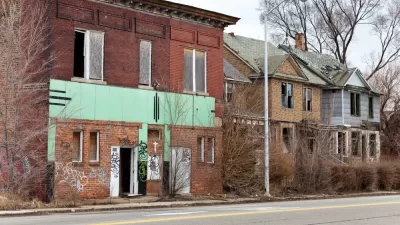While the vast majority of cities saw an increase—or no decrease—in neighborhood inequality since 1990, nearly 30 regions became more equal. But paper equality can be problematic when the rich simply up and left town.

The Urban Institute's Rolf Pendall discusses results from his recent study of neighborhood inequality rates between 1990 and 2010. As one might guess, most regions fared poorly. "But there are exceptions to every rule: in 29 of the nation's 214 commuting zones (CZs) with over 250,000 residents, neighborhood inequality went down from 1990 to 2010."
However, only in some areas did incomes actually rise across the board. "In 21 CZs, inequality fell because of shared growth, with income rising significantly in both top and bottom neighborhoods. [...] In eight CZs, inequality dropped because economic restructuring undermined the regional economies to such an extent that middle- and upper-income households either left town, retired, or took pay cuts."
Self-segregation by the rich results in segregated poverty, and, perversely, regional equality. Pendall says we need more diverse metrics to evaluate economic outcomes. He asks, "Do places and nations prevent or reduce material hardship? Do they foster economic mobility over the life course and generations? Do they assure the economic security of people who are just getting by and resilience for those whose lives are disrupted?"
FULL STORY: Is falling inequality always a good thing?

Planetizen Federal Action Tracker
A weekly monitor of how Trump’s orders and actions are impacting planners and planning in America.

Congressman Proposes Bill to Rename DC Metro “Trump Train”
The Make Autorail Great Again Act would withhold federal funding to the system until the Washington Metropolitan Area Transit Authority (WMATA), rebrands as the Washington Metropolitan Authority for Greater Access (WMAGA).

The Simple Legislative Tool Transforming Vacant Downtowns
In California, Michigan and Georgia, an easy win is bringing dollars — and delight — back to city centers.

The States Losing Rural Delivery Rooms at an Alarming Pace
In some states, as few as 9% of rural hospitals still deliver babies. As a result, rising pre-term births, no adequate pre-term care and "harrowing" close calls are a growing reality.

The Small South Asian Republic Going all in on EVs
Thanks to one simple policy change less than five years ago, 65% of new cars in this Himalayan country are now electric.

DC Backpedals on Bike Lane Protection, Swaps Barriers for Paint
Citing aesthetic concerns, the city is removing the concrete barriers and flexposts that once separated Arizona Avenue cyclists from motor vehicles.
Urban Design for Planners 1: Software Tools
This six-course series explores essential urban design concepts using open source software and equips planners with the tools they need to participate fully in the urban design process.
Planning for Universal Design
Learn the tools for implementing Universal Design in planning regulations.
Smith Gee Studio
City of Charlotte
City of Camden Redevelopment Agency
City of Astoria
Transportation Research & Education Center (TREC) at Portland State University
US High Speed Rail Association
City of Camden Redevelopment Agency
Municipality of Princeton (NJ)




























